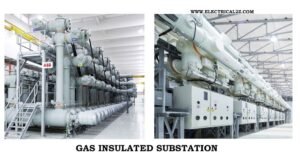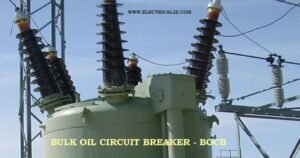This article covers various technological aspects related to circuit breakers. The arc phenomenon which is common to all circuit breakers, has been discussed in the article, covering the arc phenomenon in gases and vacuum media. Circuit breaker technologies, which are based on the medium of arc interruption have also been covered. This includes the interruption of arc in various media such as oil, air, sulfur hexafluoride (SF6) and vacuum.
The technology of gas insulated switchgear (GIS) is briefly explained in previous article. Various types of mechanisms, such as spring operated mechanism, pneumatic, hydraulic and magnetically actuated mechanisms that are used in circuit breakers are also described in this article.
Table of Contents
Arc Phenomenon: Arc in Circuit Breaker
Arc is an essential part of any circuit breaker operation where contact is physically parted. The study of arc and its behavior is necessary for switchgear designers. This article explores the various types of arcs, their properties and behavior so as to facilitate an understanding of the complexities of electrical circuit breaking. The basic design of circuit breaker interrupter essentially depends upon how the extinction of arc is managed.
The heart of an ac circuit breaker is a switching element having a variable resistance. This variable resistance is a high-pressure arc burning in the corresponding gas in various circuit breaker mediums such as air, oil and SF6. Whereas in vacuum circuit breakers, it is a vacuum arc burning in electrode vapor. In certain other switching devices, which include high-voltage dc converters, is either a low-pressure mercury arc or a ‘discharge’ in the crystal lattice of a solid state device.
The physics of discharges in circuit breakers is understood only qualitatively. Many of the processes occurring during this phenomenon are too complex to be subjected to analytical treatment. Since our knowledge of gas properties, particularly at high temperatures, is not very accurate, there are several uncertainties. Nevertheless, progress in circuit breaker-arc physics has been considerably rapid in the last 10-15 years, owing mainly to advances in aerodynamics, and computational and experimental techniques.
The study of arc phenomena, though very complex, is of immense importance for understanding the design and operational characteristics of circuit breakers. In this article, an attempt has been made to discuss some of the physical processes, which are vital to an understanding of the phenomena of electric arcs.
Role of Arc in Current Interruption
When two current-carrying contacts open, an arc bridges the contact gap and prevents an abrupt interruption of the current. This arc is useful in a way as it provides a low resistance path for the current after contact separation, thereby preventing current chopping and associated abnormal switching overvoltage in the system. In the case of alternating current (ac), arc is momentarily extinguished at every current zero. To make the interruption complete and successful, reignition of the arc between the contacts has to be prevented after a current zero.
It is thus evident that the arc plays an important role in the process of current interruption and therefore must not be regarded as an undesirable phenomenon. It must also be realized that, in the absence of the arc, the current flow would be interrupted instantaneously, and due to the rate of collapse of the associated magnetic field, very high voltage would be induced which would severely stress the insulation of the system. On the other hand, the arc provides a gradual, but quick, transition from the current-carrying to the current-breaking states of the contacts. It thus permits the disconnection to take place at zero current without inducing the potentials of dangerous values. The function of an arc-control device in a circuit breaker is therefore clearly to employ the beneficent action of the arc as efficiently as possible.
Arc Interruption Theories – Arc in Circuit Breaker
In the early 1930s, Slepian put forward the concept of a ‘race’ between the growing dielectric strength of an arc gap after arc extinction and the re-striking voltage of the circuit. However, it was realized later that the two quantities were not independent of each other, which led Cassie in 1939 to put forward the first energy-balance theory of arc extinction, and Slepian and Browne in 1941 to suggest that turbulence in the gas flow was the means by which the rapid dissolution of the arc was obtained. At this time, a considerable amount of work, both experimental and theoretical, commenced around the world, on the manner in which the resistance of the arc changed during the current zero period.
In 1939, Cassie proposed a model of arc in which the arc was assumed to have a cylindrical column with a uniform temperature and current density, so that its area varies to accommodate changes in the current. The power dissipation was assumed to be proportional to the column cross-section. This model was intended to represent an air-blast arc and was represented by the following differential equation:
Rd/dt (1/R) = 1/θ {(v/v0)2 – 1}
Where R is the arc resistance, v, the arc voltage at any instant, v0, the arc voltage in steady state, and θ the arc time constant (i.e. the ratio of energy stored per unit volume to the energy loss rate per unit volume).
In the steady state, Cassie’s equation leads to a constant voltage characteristic v = vg, which is qualitatively typical of the heavy circuit regime of circuit breaker arcs.
A few years later, in 1943, Mayr proposed a somewhat improved model, in which the arc was assumed to be of a fixed diameter but of varying temperature and conductivity, and the power loss occurred from the surface of the arc only. This model was described by the differential equation:
Rd/dt (1/R) = 1/θ {(v/w0)2 – 1}
where i is the arc current at any instant and w0 is the energy loss from periphery of arc at steady state.
It has been found that Cassie’s model best describes the period before current zero whereas Mayr’s model represents better the post-arc regime. In 1948, Browne developed a model of the arc that combined both these models. Many other models have also been proposed since then, but none of them relates the terms of the equation numerically with the physical properties of the interrupting medium. An exception, however, is the theory evolved by Butler and Whittaker in 1972.
The fact that energy is stored in the arc column means that the conductance will fall to zero only some time after the current zero and some ‘post-zero’ current will flow. If immediately after current zero, the rate of rise of recovery voltage is greater than a critical value, the decaying arc channel is re-established by ohmic heating. In this period, which is controlled by the energy balance, thermal failure can therefore occur. After a successful thermal interruption, the restriking voltage can reach such a high peak value that the gap fails through dielectric breakdown. This is called dielectric failure in the peak regime of re-striking voltage. A typical feature of this failure mode is that the voltage decay occurs so fast that it cannot be resolved on an oscillogram while the voltage in the thermal failure mode decreases and approaches the arc voltage during a time interval lasting for several microseconds. The nature of voltage variation with time under the two failure modes is illustrated in image.
Arcing Process | Arc in Circuit Breaker
Arcs in ac circuit breakers occur in two ways. When the current-carrying contacts are being separated, arcing is possible even when the circuit e.m.f.is considerably below the minimum cold electrode breakdown voltage, because of the ions neutralizing the electronic space charge and thus allowing large currents to flow at relatively low voltage gradients. This way of occurrence of an arc is common to both de and ac circuit breakers.
 |
| The nature of voltage variation with time under two failure modes |
The another way of occurrence of arc happens only in ac circuit breakers. In this case, the arc is extinguished every time the current passes through zero and can re-strike only if the transient recovery voltage across the electrodes, already separated and continuing to separate, reaches a sufficiently high value causing breakdown.
The function of an ac circuit breaker is to prevent re-striking of the arc, which depends upon the following important factors:
• The nature and pressure of the medium of arc.
• The external ionizing and de-ionizing agents present.
• The voltage across the electrodes and its variation with time.
• The material and configuration of the electrodes.
• The nature and configuration of the arcing chamber.
To the physicist, the arc appears in many forms and is a subject of great scientific interest. To the switchgear designer, the arc all too often appears to have only one objective, viz. self preservation. The power arcs try to evade de-ionization systems by striking in new and unexpected directions, and by re-igniting after they appear to have been successfully interrupted, if the design has any weakness. Thus while the physicist would be interested in studying the arc plasma properties, including particle densities, temperatures and distributions, and electrical conductivity, the switchgear designer would be more concerned with the insulating and dielectric recovery properties of the arcing medium so that he can use them to interrupt as high a current and voltage as possible.
Arcs used in circuit breakers can be broadly classified into two categories, viz. high pressure arcs, with ambient pressures of one atmosphere and above, and vacuum arcs, with ambient pressures below 10% Torr. Since neither mercury arcs nor semiconductor junctions have been used in normal circuit breakers, these types of discharges are not discussed in this chapter.
High pressure Arcs: Arc in Circuit Breaker
The arc interrupting medium in high-pressure circuit breakers is a flowing gas, commonly either air or SF6 in blast type circuit breakers, and hydrogen in oil circuit breakers. Table shows the actual composition of the gases involved in different circuit breakers, as also the nominal composition used for theoretical studies and the pressure ranges involved. From the table, it is clear that the gases involved most often are air, nitrogen, hydrogen, and sulphur hexafluoride.
 |
| Pressure and Composition of Gases in Circuit Breakers |
The high-pressure arc may be taken to consist of three distinct regions: (1) cathode region, where electrons and metal vapour are emitted from the metal electrode into the plasma, either by field or by thermionic emission, (2) an arc column, where the current is carried by moving electrodes and ions, and (3) an anode region, where electrons from the discharge enter the electrode, and where metal vapour may also enter the discharge.
Electrode Regions
The electrode regions are usually considered to be relatively unimportant, as far as arc extinction is concerned, in most high-pressure circuit breakers. However, it is useful to study some properties of these regions. In front of the cathode, the arc usually constricts into a bright spot with a very high current density, which may vary from 10’ to 10′ A/sq.mm. depending on the material and the experimental condition. The cathode voltage drop is usually quite low, around 10 V. In front of the anode, the appearance of the contraction is usually not quite as pronounced. However, the anode voltage drop is also comparable to the cathode voltage drop.
The constriction of the arc near the electrodes causes vapor jets to form. These jets can affect the performance of arc chutes and arcing horns in arc-chute circuit breakers, and can significantly affect the ionization and thermal conditions of the arc column in blast type circuit breakers.
Plasma Region (Arc Column)
The arc column in the high-pressure arc is a cylindrical region in which ionized gas gives almost the exact equality of positive and negative charge density, so that very high current densities may be supported with relatively low electric fields.
Ionization Processes
Ionization in arcs takes place when any process occurs in which sufficient energy can be supplied to neutral particles to detach one or more electrons. This energy may be supplied by the direct impact of electrons, positive ions, neutral atoms or photons. All of it need not be supplied in one encounter; as a particle may be excited by one collision and ionized by the next.
In circuit-breaker arcs, two major processes produce the ionization. During most of the current conduction period, the ionization that takes place is almost wholly thermal ionization, owing to the thermal agitation of the very hot gas particles, but ionization by direct electron impact in the electric field of the discharge can also occur very close to current zero. It is generally believed that the amount of ionization produced in arcs by other processes is very small.
Thermal Ionization
An ideal gas at normal temperature is a good electrical insulator, because it consists of molecules most of which are in the ground state and hence electrically neutral. It can be made to conduct only when some means are employed to create free electrons and ions. Although some free electrons and ions are present in the gas, which are created by ultraviolet radiation, cosmic rays, radioactivity of the earth, etc., these are, as such insufficient to sustain conduction through the gas.
In order to understand how the gas becomes conducting, it must be remembered that a gas consists of molecules which move about with considerable velocities and which are not all the same but are grouped about a mean value in a Maxwellian distribution. The mean kinetic energy of the molecules, 1/2 mv? Is equal to 3/2 kT, where T is the absolute temperature and k, the Boltzmann’s constant.
It is common knowledge that air molecules at room temperature (300° K) move randomly at a speed of approximately 500 m/second and collide very frequently at 10″ times/sec. Nevertheless the kinetic energy of these molecules (the average of which is proportional to the absolute temperature) is too low to enable even the fastest particles to excite those with which they collide.
If the gas is heated up, some of molecules will breakdown at the most severe collisions and dissociate into their atoms. Energies of 5.1 eV and 9.1 eV respectively are needed to dissociate an O, and N, molecule.
As the temperature is increased further, some molecules and atoms are deprived of some valance electrons and the ionized gas called plasma becomes a conductor. This process accounts for much of the conductivity in low-voltage arcs. The degree of ionization depends on the pressure, the temperature and the ionization potential of the gas or vapor.
The ionization potential is the work done in removing an electron from an atom or molecule and is measured in electron volts; more than one electron may be removed per particle in highly ionized plasmas. The degree of ionization X in a thermally-ionized gas was first derived by Saha in 1920 on the basis of thermodynamic reasoning and is given by the following equation:
{X2/(1 — X2)} p = 3.16 x 10-7 T5/2 exp (eVi, /kT)
where p is the total pressure in atmosphere, T, the gas temperature in degrees Kelvin, e, the electron charge in coulombs, Vi the ionization potential of the gas atoms in electron volts and k, the Boltzmann’s constant. In many practical cases, the degree of ionization is sufficiently small to justify the simplifying substitution of unity for (1 — x2). The ionization potentials are as follows:
Cu (vapor) = 7.7 eV N2 = 15.5 eV
O2 = 12.2 eV F2 = 17.8 eV
H2 = 15.4 eV S=103 eV
An important characteristic of the arc plasma when considering the arc extinction process is its thermal conductivity. Figure compares the thermal conductivities of SF6 and Nitrogen (N2). The peaks in the curves correspond to the molecular dissociation temperatures which are around 2000 K for SF6 and 6500 K for N2. The result of this is that the arc plasma in SF6 is surrounded by a cylinder of cool gas with a high thermal conductivity and a very low electrical conductivity. In a Nitrogen arc the outer surface is at a much higher temperature and correspondingly more conductive.
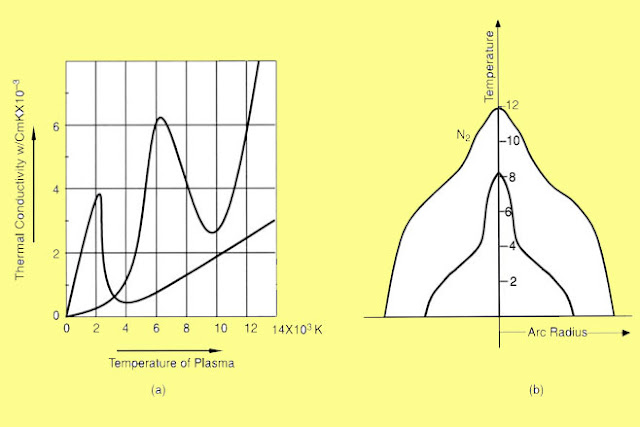 |
| (a) Thermal conductivity of SF and N, (b) SF and N arc temperature profiles |
This is illustrated in picture which shows temperature profiles for both gases. The result of the cool gas around the arc plasma and the small diameter of the arc core in the SF6 arc gives it a very short thermal time constant, which is important when considering the extinction process.
Ionization by Electron Collision
Ionization by electron collision occurs in a gas by electrons that are directly accelerated by high electric gradients in the arc. In this case, the electron velocities are not only much higher than they would be if they were in thermal equilibrium with the surrounding gas at arc temperatures, but are no longer random in direction and are directed by the electric field. The probability of ionization by collision is, of course, zero when the impacting electron has less energy than the ionization potential of the gas.
De-ionization, Recombination and Attachment Processes
If all sources of ionization are removed from an ionized gas, it rapidly assumes a neutral state by ion diffusion to the walls and by volume recombination of the positive and negative ions. In de-ionization by diffusion, the negative ions, or electrons, and positive ions move to the walls under the influence of concentration gradients, and thus completing the process of recombination.
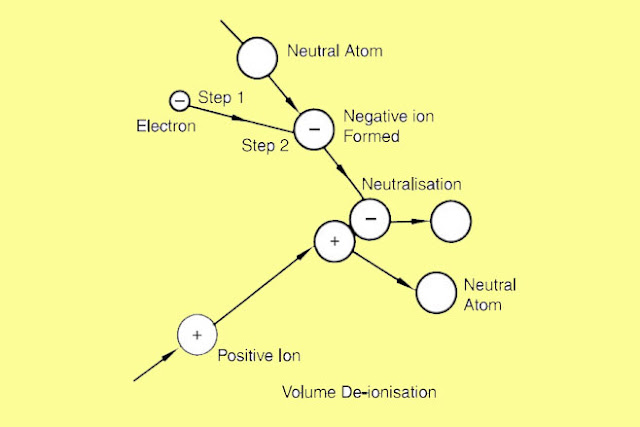 |
| Re-combination of +ve and –ve ions |
The probability of electron attachment varies widely with different gases and is markedly affected by the presence of certain gases and vapor as impurities. The gases with this property of attaching an electron are termed as electronegative gases. This electron affinity of a gas is expressed in electron volts, and varies from zero for noble gases to a maximum of 3.9 eV for fluorine. Some values are as follows:
 |
| De-ionization at Surfaces |
F=39eV H=O07eV
Cl=38eV O,=1eV
The mean time of electron attachment is the average time for which an electron will exist free in a gas at normal temperature and pressure (NIP) before being absorbed by a neutral particle to form a negative ion. Table shows the value of mean time of electron attachment in seconds for different gases.
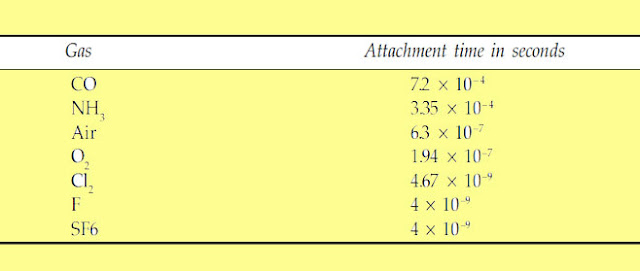 |
| Mean time of electron attachment |
The table shows that an electron in pure CO would remain free on an average for about 7 x 107 sec, while in F or SF6 it would remain free for only about 4 x 10~ sec. The noble gases do not form negative ions by attachment of electrons nor do pure nitrogen and hydrogen. Obviously, an electric field would speed up the electrons so as to render attachment improbable. High temperatures also reduce the probability of attachment so that in a high-pressure arc column, few negative ions are likely to form an attachment. When oppositely charged particles re combine to form neutral particles, they emit energy, which is equal in amount to the original ionization energy of the particles. The ionization and recombination processes go on simultaneously in an arc while in an equilibrium situation, the rate of ionization exactly balances the rate of recombination.
With decreasing current, re-combination of additional charged particles takes place to adjust the arc condition to new values of current. Recombination occurs more rapidly at low temperatures, i.e. when the arc is cooled by external means, than at high temperatures. In vacuum interrupters, where the mean free path is many cm long, the recombination takes place mainly on solid surfaces. In high-pressure circuit breakers, however, this process is not important, because the mean free path, of the order of 10-5 cm and below is so short that ions in the critical region of the discharge channel almost never meet solid surfaces.
Arc Column Characteristics | Arc in Circuit Breaker
In the high temperature arc column, the particles are in thermal equilibrium. They are all in rapid random motion, but in the absence of an electric field, no net movement occurs. When an electric field is applied to the gas, the charged particles gain a drift velocity superimposed on their random thermal motion. The drift velocity is proportional to the voltage gradient, with the coefficient of proportionality being termed as the particle mobility.
The heavier the particle, the lower the mobility, since the particle loses its directed velocity at each collision of the random walks, and has to be re-accelerated in the direction of the field again. Similarly the higher the pressure, the lower the mobility, since collisions occur more frequently.
 |
| Electrical conductivity of air at different temperatures |
The contribution to the total current by the charged particles is directly proportional to their mobility and hence to ion current. This ion current is only a very small fraction, about 0.1 per cent of the total current, and is usually neglected. When an electronegative gas is present, the electrons become attached to form negative ions as the temperature falls and thus the conductivity of the arc column reduces very rapidly. This attachment is of great importance in SF6 circuit breakers during and after the current—zero periods. Thus if the nature of the gas is known, it is possible to calculate many of the electrical properties of the plasma as a function of temperature, since the ionization density can be calculated from the temperature by the Saha equation. The calculated electrical conductivity of air at different pressures as a function of temperature is shown in figure.
 |
| Typical static and 50 Hz characteristics |
The relationship between arc current and arc voltage is known as the arc characteristic. The static characteristics apply when changes of current impressed on the arc take place slowly, while the dynamic characteristics apply when these changes take place rapidly. Image shows typical static and 50 Hz characteristics. With an increase in the arc current, the temperature rises and the process of ionization becomes more active, thereby increasing the conductivity of the medium and resulting in a decrease in the arc voltage. The initial breakdown of the gap between the electrodes requires a high ignition voltage Vi at zero current.
If the current through the arc changes suddenly, in step-function form, the arc initially acts as a linear resistor, with the voltage change being proportional to the change in current. Since the conductance of the arc depends on the stored energy, it cannot change instantly but exponentially approaches the level determined by the static characteristic for the new value of current. In air blast arcs, the arc time constants are short (10 to 100 micro seconds) because of a very large ratio of power loss to energy stored, whereas in freely burning atmospheric pressure arcs, the voltage may take a millisecond or more to return to the value given by the static characteristic. – Ve represents the extinction voltage.
Heat Loss from Arc Plasma
The heat loss from an arc column can take place through three mechanisms: conduction, convection and radiation. In breakers with plain break arc in oil, arc in chutes or tubes or narrow slots, nearly all the heat loss is due to conduction. If, however, a gas flow is present either due to the action of the arc itself (as in an ordinary arc in air) or to an external blast, the loss occurs due to a conduction-convection process. At pressures close to 1 atm, radiation is not a significant factor in heat dissipation from the arc. At these pressures, the arc can also be considered as optically thin, ie. the radiation from the inner portion of the arc is not absorbed to any significant degree before it leaves the plasma. At higher pressure, however, the radiation may become a very important factor in energy dissipation and the plasma also becomes optically thick. In order to understand the quantitative effects of radiation, all known emission processes must be considered.
Arc Extinction | Arc in Circuit Breaker
The final extinction of the arc requires a rapid increase of the dielectric strength in the medium between the circuit breaker contacts, which is achieved either by the de-ionization of the arc path or by the replacement of the ionized gas by cool fresh gas. The various de-ionization processes include high pressure, cooling by conduction, forced convection and turbulence.
At a given temperature, a pressure increase results in a corresponding increase in the density and reduction in mean free path of the particles constituting the discharge. This increases the collision rate and the voltage required to maintain the arc. Another effect of the increased density of particles is a higher rate of de-ionization due to the re-combination of oppositely charged particles.
The voltage required to maintain ionization increases with a decrease in temperature because cooling effectively increases the resistance. Cooling by conduction of arc heat to adjacent parts, e.g. baffles, splitters and insulating walls, or by the use of a gas such as hydrogen that has high diffusion rate, heat absorption rate and thermal conductivity, is therefore effective in arc extinction.
Efficient cooling is also achieved by forced heat convection, which may be brought about by a gas blast directed along the discharge as is done in air blast and SF6 circuit breakers. Such a blast also compels the arc to shrink in diameter. Under certain conditions, a flow of gas creates turbulence near the surface of an arc, and it is believed that this effect may be very important in arc extinction.
Vacuum Arc – Arc in Circuit Breaker
General Characteristics: The vacuum arc differs from the general class of low and high pressure arcs in the sense that in vacuum arc, the electrons, ions, and neutral atoms are all derived from the electrodes by the arc itself. The base gas pressure here is so low that it plays no significant role in the conduction process. In this sense, the vacuum arc is therefore really a metal vapour discharge.
An ac vacuum arc between two simple disc-shaped electrodes burns in either a diffuse or a constricted mode, depending largely on the magnitude of the current and the size and spacing of electrodes. With copper electrodes of dimensions typically found in a vacuum interrupter, the arc would generally burn in a diffuse mode at currents up to about 10 KA and ina constricted form, above this current.
Cathode Region
The vapor necessary to sustain vacuum arc comes mainly from the cathode spots. Each spot carries a mean current dependent on the cathode material, which is about 100 A for copper. The current density at the spots is estimated to be 1010-1011 A/ m7, depending on the cathode material.
In the absence of magnetic fields, a single cathode spot moves randomly on the cathode surface with a small velocity. At higher currents, when many spots exist in parallel, the self-magnetic fields are more intense, and the motion of the spots due to mutual repulsion may predominate over their random motion and corresponds to the retrograde motion of the spots in an external magnetic field.
The arcing voltage at low currents (< 300 A) which is confined to the cathode region, depends wholly on the cathode material and is related to the physical properties of material. The value is generally in the range 8-30 V depending on the material. At high currents (a few kiloamperes), however, there can be appreciable plasma and anode voltage drops.
Plasma Region
The region between the electrodes of a diffuse vacuum arc is roughly conical in shape, the apex of the cone being at the cathode spot and the base on the anode as shown in picture. The general picture of vacuum arc is illustrated diagrammatically in figure. The vapour, which has a high density at the cathode spot, expands into the vacuum and perhaps at a distance of 10 mm from the cathode, the density will be representative of a pressure of 10~ torr. Thus, an electron traversing the inter-electrode gap experiences conditions of high pressure near the cathode where the mean free path is perhaps 10~ m, to conditions of low pressure in the plasma where it is of the order of tens of millimeters.
At low currents, the voltage drop in the plasma region of a low-current arc is negligible. The voltage gradient is less than 0.01 V mm“. At high currents, however, the gradient may be up to a few volts per millimeter.
Current-zero Processes
Successful current interruption by a vacuum arc depends upon the rapid condensation of the metal vapor into the anode and shield near and at current zero. As the current falls, the number of cathode spots falls until we have only one spot at currents between 100 A and zero.
 |
| Vacuum arc diagram – Arc in Circuit Breaker |
The estimated values of metal vapor density, which are in good agreement with the measurements, are so low throughout the gap that the gap is substantially an insulator. This prevents reignition of the vacuum arc after the current zero.
Final Word
Hope you understand this article about Arc in Circuit Breaker | Arc Extinction. Incase of any doubt please comment below. Subscribe our website to get every new post update to your email. Please follow our website – ElectricianWorld.net for future updates. Thank you for visiting our website.

